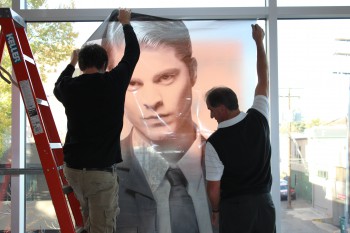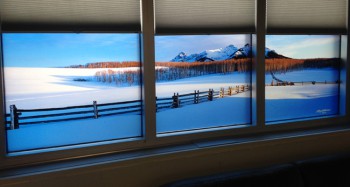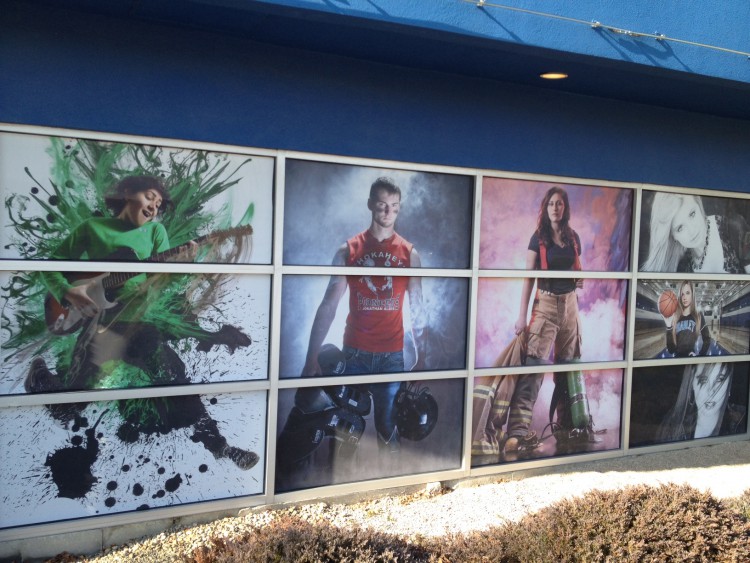When it comes to printing window graphics, the technology and application possibilities have exploded in recent years, thanks to new films and clings that have hit the market. Window graphics have been used in the bottling market for years on store windows, in particular. But with all of the new options available today, even more environments — like retail outlets and corporate offices — are getting their messages and imagery beyond the walls and onto the windows.
But it’s important to know: Not all window graphic media options are created equal.

“Each substrate has its own nuances to consider,” Digital Output magazine reported in its October 2015 issue. “Such as whether it is adhered to the outside or inside of the glass, ink type compatibility and special print challenges.”
But that doesn’t mean it has to be a challenge to find the right window media for the job. “You basically have three options: Low-tack films and vinyls (in clear, white or backlit), static clings or perforated media,” says LexJet’s Michael Clementi. “You can also add a removable adhesive to any product.”
Low-Tack Vinyl & Films
For solvent, UV-curable and latex printers, LexJet’s Simple Low Tack Vinyl in clear or white is a go-to option for window graphics. The white vinyl is used for exterior-mounted graphics — on the outside of the window, facing out. It can also be used on the interior of the window, facing in. The clear option can be reverse printed so it can be installed on the inside of the window, facing out, and protected from the outdoor elements.
“The catch with the clear vinyl is that it has no white point,” Clementi says. “So you either need a printer with white ink or you need to apply a white backer with a laminator.”
While vinyls are certainly a cost-effective temporary option, they may not stand up to the variations in climate, like cold mornings and hot afternoons. “Once it’s been up for a while, vinyl will expand and contract, and the adhesive will break down, causing curling along the edges,” Clementi says. Opting for a low-tack film like LexJet Crystal Low-Tack Polyester is a great aqueous-compatible option with a pressure-sensitive adhesive that can be front- or reverse-printed for inside or outside viewing.
Another option is LexJet Print-N-Stick for aqueous printers and the new LexJet Solvent Print-N-Stick, which have a smooth, bright-white textile finish that’s water resistant and can be displayed for about a year before they need to be replaced.

An exciting addition to the window films market is LexJet Simple Grip Backlit for latex printers, which will be launched later this month. Unlike traditional backlit films, this one can applied to windows and the image can be seen from either side, and it can be lit from the front or the back. “It’s not a milky-white backlit, but more like a frosted finish,” says Clementi, who has been testing the new product in LexJet’s Experience Center in Sarasota, Fla. “When you really want your imagery to light up and pop, you’ll see that the light refracts perfectly off Simple Grip Backlit.”
Static Clings
Cling vinyls will also be adversely affected by the elements, and the newer polypropylene clings solve that problem. LexJet introduced the dimensionally stable and water-resistant PVC-Free Cling in White and Clear in early 2014.
These latex, solvent and UV-curable compatible clings utilize a silicone-like technology that eliminates bubbling, and was inspired by the same innovation used in cell phone screen protectors. This advancement makes cling installation a breeze, and the graphics can be repositioned and reused without leaving any residue behind. Watch this video to see it in action.
Perforated Media
Graphics printed on perforated media add a benefit of being able to still see through the glass that the graphic is applied to, thanks to the tiny holes punched into the media. LexJet carries three perforation options: 50/50 vinyl, 60/40 vinyl and 70/30 vinyl. In a 50/50, the holes in the perforation are larger, and equal in space to the remaining printable material.
In a 60/40, there is more printable space in relation to the perforated holes, and even more printable space in a 70/30. The various options are available because some states mandate that a graphic applied to a car window be 50/50 or 60/40.
“If it’s not applied to a vehicle, always use 70/30,” Clementi says. “There’s really not much difference in visibility through them, but with a 70/30, you’ll get far better image quality since there’s more space to print on.” Plus, he says, graphics with more details will print better on the increased print surface of a 70/30.
No matter what type of messaging or window you need to apply a graphic to, there’s likely a product that’s ideal for the application. One of our LexJet experts can help determine the right products to fit your customers need and help you increase the options you can offer them. Call us today at 800-453-9538. If you’ve printed a window graphic for a customer that you’d like us to feature on this blog, please email shellie.benson@lexjet.com.



I love vinyl window films. The combination of transparency and occlusion merged with the high-resolution colours gives an appealing look to glass windows and doors.